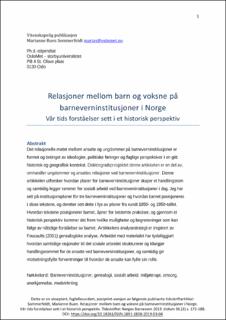Relasjoner mellom barn og voksne på barneverninstitusjoner i Norge Vår tids forståelser sett i et historisk perspektiv
Peer reviewed, Journal article
Accepted version
Permanent lenke
https://hdl.handle.net/11250/2987746Utgivelsesdato
2019-10-16Metadata
Vis full innførselSamlinger
- Publikasjoner fra Cristin [3269]
- SAM - Institutt for sosialfag [471]
Originalversjon
Tidsskriftet Norges Barnevern. 2019, 96 (3), 172-188. https://doi.org/10.18261/ISSN.1891-1838-2019-03-04Sammendrag
Det relasjonelle møtet mellom ansatte og ungdommer på barneverninstitusjoner er formet og betinget av ideologier, politiske føringer og faglige perspektiver i en gitt historisk og geografisk kontekst. Doktorgradsprosjektet denne artikkelen er en del av, omhandler ungdommer og ansattes relasjoner ved barneverninstitusjoner. Denne artikkelen utforsker hvordan planer for barneverninstitusjoner skaper et handlingsrom og samtidig legger rammer for sosialt arbeid ved barneverninstitusjoner i dag. Jeg har sett på institusjonsplaner for tre barneverninstitusjoner og hvordan barnet posisjoneres i disse tekstene, og deretter sett dette i lys av planer fra rundt 1850- og 1950-tallet. Hvordan tekstene posisjonerer barnet, åpner for bestemte praksiser, og gjennom et historisk perspektiv kommer det frem hvilke muligheter og begrensninger som kan følge av nåtidige forståelser av barnet. Artikkelens analysestrategi er inspirert av Foucaults (2001) genealogiske analyse. Arbeidet med materialet har tydeliggjort hvordan samtidige rasjonaler til det sosiale arbeidet strukturerer og klargjør handlingsrommet for de ansatte ved barneverninstitusjoner, og samtidig gir motsetningsfylte forventninger til hvordan de ansatte kan fylle sin rolle. This article is part of a phd-project exploring the relationships between adolescents and social workers at the child welfare residential care homes. The relationships between adolescents and social workers in residential care homes are shaped and conditioned by ideologies, political guidelines and professional perspectives in a given historical and geographical context. This article explores how plans for residential care homes create room for actions, while at the same time setting limits for social work at the residential care homes today. I have looked at plans from three residential care homes and how the child is positioned in these texts, and then seen these in the light of plans from the 1850s and 1950s. How the texts position the child opens for certain practices, and through a historical glance, it identifies the possibilities and limitations that can result from current understandings of the child. The article's analysis strategy is inspired by Foucault's (2001) genealogical analysis. The work on the material has clarified how simultaneous rationalities and expectations of social work structure the room for the employees of the child welfare institution, at the same time provides contradictory expectations on how the emloyees should do their job.
